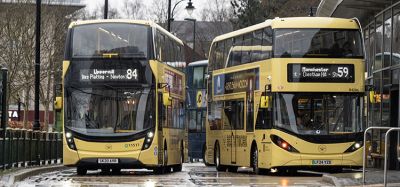On our way to 10 million daily transactions
- Like
- Digg
- Del
- Tumblr
- VKontakte
- Buffer
- Love This
- Odnoklassniki
- Meneame
- Blogger
- Amazon
- Yahoo Mail
- Gmail
- AOL
- Newsvine
- HackerNews
- Evernote
- MySpace
- Mail.ru
- Viadeo
- Line
- Comments
- Yummly
- SMS
- Viber
- Telegram
- Subscribe
- Skype
- Facebook Messenger
- Kakao
- LiveJournal
- Yammer
- Edgar
- Fintel
- Mix
- Instapaper
- Copy Link
Posted: 30 June 2010 | Pier Aldershof, Manager of Certification & Security, Trans Link Systems | No comments yet
Trans Link Systems (TLS), a joint venture based in Amersfoort, was founded in 2001 by the five largest Public Transport Operators in the Netherlands. Connexxion (the trans-regional bus service), GVB (Amsterdam’s public transport operator), HTM (the public transport group for The Hague), NS (Netherlands Railways) and RET (Rotterdam’s public transport operator). It services all other public transport organisations. TLS, as an independent governing body, facilitates the introduction of the national OV-chipkaart system in the Netherlands. The OV-chipkaart is a single contactless smart card for public transport costs that can be used on any bus, train, tram, ferry and metro within the Netherlands.
Trans Link Systems (TLS), a joint venture based in Amersfoort, was founded in 2001 by the five largest Public Transport Operators in the Netherlands. Connexxion (the trans-regional bus service), GVB (Amsterdam’s public transport operator), HTM (the public transport group for The Hague), NS (Netherlands Railways) and RET (Rotterdam’s public transport operator). It services all other public transport organisations. TLS, as an independent governing body, facilitates the introduction of the national OV-chipkaart system in the Netherlands. The OV-chipkaart is a single contactless smart card for public transport costs that can be used on any bus, train, tram, ferry and metro within the Netherlands.
Trans Link Systems (TLS), a joint venture based in Amersfoort, was founded in 2001 by the five largest Public Transport Operators in the Netherlands. Connexxion (the trans-regional bus service), GVB (Amsterdam’s public transport operator), HTM (the public transport group for The Hague), NS (Netherlands Railways) and RET (Rotterdam’s public transport operator). It services all other public transport organisations. TLS, as an independent governing body, facilitates the introduction of the national OV-chipkaart system in the Netherlands. The OV-chipkaart is a single contactless smart card for public transport costs that can be used on any bus, train, tram, ferry and metro within the Netherlands.
Prior to the introduction of the OV-chipkaart in the Netherlands, comparable electronic payment systems for public transport were already in use in other countries. In 1997, the Octopus card was put into operation in Hong Kong (this smart card is the main example for the OV-chipkaart system). The Oyster card has been in operation in London since 2003. Nevertheless, the OV-chipkaart is unique as it is the very first time that a country, with various public transport companies operating shortdistance and long-distance travel options, converts to a single electronic smart card system. All card readers, access gates and top-up machines may freely develop their own equipment as long as it meets the agreed technical specifications. This allows the public transport companies to select their supplier for the equipment they need to purchase.
Back-office system
Travellers can start their journey by checking in with their contactless card at gates at stations or validators in buses. At the end of the journey, the travellers are required to check-out. The check-ins and check-outs generates transactions, which are processes in the central back-office. The back-office system is managed by TLS and is not continuously in contact with the smart card readers and gates (offline). The smart card readers in the bus store the data in a central processor in the vehicle itself. When the bus reaches the depot, the data is read and sent to the back-office. The fixed gates at metro and train stations contact the back-office approximately every fifteen minutes. This system does not operate in the same manner as, for example, PIN card payments where the system is in contact with the central Equens back-office system for the approval of the transaction. Equens is the company in the Netherlands handling banking transactions. An online system is not feasible for the public transport sector, if only because of the fast flow of passengers. The offline system entails that a large section of the intelligence of the system is included in the smart card and the equipment at the stations and in vehicles.
The smart card processes everything the passenger requires using the available equipment. When checking in and out, the smart card is first authenticated. Next, the smart card and the equipment (based on the travel products stored on the smart card) determine the cost of a journey at check-out. The balance of the travel costs is subsequently processed and stored on the smart card. This may be a complex calculation. If a passenger, for example, travels partly within the season ticket region indicated on the travel product on the smart card and partly using the OV-chipkaart credit, this has to be processed by the smart card without errors.
Scheme Provider
One of the roles that TLS takes up aside from the role of Card Issuer and Clearing Operator, is the role of Scheme Provider. As the Scheme Provider, TLS is responsible for the security of the system and the correct use of the system by all connected parties. Every company connected to the OV-chipkaart system should use the same guidelines to design their systems and processes. Thereby ensuring the complete system works seamlessly and creating a safe and reliable environment to process the financial transactions correctly. The system has an open architecture, where specifications as well as source code are provided to vendors. Several vendors currently supply equipment which can be connected to the central OV-chipkaart system. The companies involved are, therefore, not dependent on a single supplier. This has not only led to substantial lower costs of ownership of equipment. More importantly, it has created a competitive market where the creativity of suppliers lead to an interesting set of front end devices such as compact Add Value Machines for value top-up and product sales. More recently, the low cost Pick-up Device was introduced to allow customers to carry out sales or value top-up actions using the Internet. This is another facility which was developed based on the aforementioned approach.
Pick-up device
The fact that the OV-chipkaart operates offline creates a problem the passenger does not completely understand: How can I add the products (such as season tickets, e-purse credit or discounts) recently purchased online on to the smart card? Pick-up devices which are often integrated in the OV-chipkaart top-up machines have been defined as a solution. These pick-up devices were in the news at the beginning of this year because students could go to these devices to add their student season tickets on to their OV-chipkaart. Technical problems, however, created chaos at these devices.
‘Transaction factory’
The TLS back-office system is mainly used to settle the accounts between the card issuer and the public transport companies as well as for performing additional checks. The step-by-step introduction of the OV-chipkaart meant that the system had to process a steadily growing number of transactions. In the first quarter of 2010, we have already processed more than 250 million transactions. That is approximately three million daily transactions. Once the OV-chipkaart is implemented throughout the country, daily transactions will total 10 million. TLS searched the world for proven components in order to have a system which could handle this enormous flow of data. We finally decided on the Octopus system used in Hong Kong. Our back-office system is the same as the system which has proven itself for more than 10 years in Hong Kong. It operated correctly from the start.
Alongside the ‘transaction factory’, the TLS ICT architecture includes another important system node for the OV-chipkaart. This is a system in which customers and orders are registered and the orders are logistically processed (such as issuing the OV-chipkaart). System access through the Internet is also possible and the customers can view the data on their own OV-chipkaart and order season tickets, tickets or discounts which can subsequently be picked up.
Growth
The growth of the OV-chipkaart, even after the complete implementation throughout the country, has not come to an end. In the background we are already researching the opportunities for payments outside the public transport sector. It would be great if the OV-chipkaart could be used for a large variety of issues related to mobility such as parking, taxis or even catering at or near train stations. We do not even exclude the integration of the OV-chipkaart with bank cards: we are currently discussing the options. When we started working with the OV-chipkaart, the banks were not ready. It is certainly an option for the far future. TLS believes the danger lies in letting the technology take over and losing sight of the interests of passengers. The tech – nology provides various opportunities. We have the duty to ensure that the system is simple and useful for all people.
About the author
Pier Aldershof
Pier Aldershof joined Trans Link Systems in 2004 in the role of Manager of Certification & Security. In this position, he has set up a team of professionals that developed the specifications and certification tests for the Dutch Interoperable Fare System. These specifications have successfully led to an open and competitive market for IFS components in the Netherlands.
Related topics
Ticketing & Payments
Issue
Issue 3 2010








